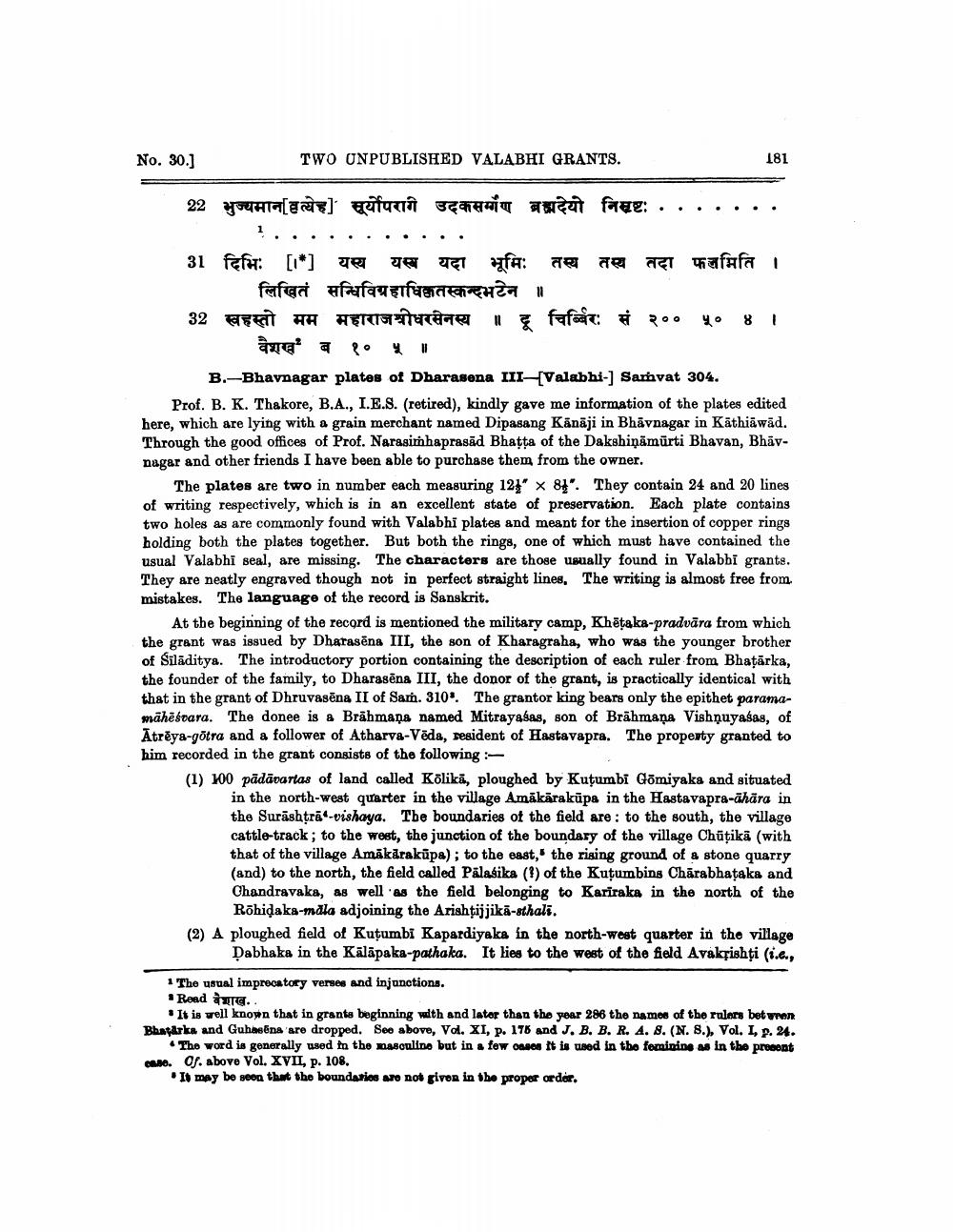________________
No. 30.]
TWO UNPUBLISHED VALABHI GRANTS.
181
22
PH[ET] guitacît 5gmhio ameet fare: .......
31 fefH: [*] Je Je u fa: e l arafa
लिखितं सन्धिविग्रहाधिक्कतस्कन्दभटेन ॥ 32 स्वहस्तो मम महाराजश्रीधरसेनस्य ॥ टू चिबिरः सं २०० ५० ४ ।
वैशख' ब १० ५ ॥ B.-Bhavnagar plates of Dharasena III–Valabhi-) Samvat 304. Prof. B. K. Thakore, B.A., I.E.S. (retired), kindly gave me information of the plates edited here, which are lying with a grain merchant named Dipasang Känäji in Bhavnagar in Käthiāwād. Through the good offices of Prof. Narasimhaprasad Bhatta of the Dakshinamurti Bhavan, Bhavnagar and other friends I have been able to purchase them from the owner.
The plates are two in number each measuring 12%" x 81". They contain 24 and 20 lines of writing respectively, which is in an excellent state of preservation. Each plate contains two holes as are commonly found with Valabhi plates and meant for the insertion of copper rings holding both the plates together. But both the rings, one of which must have contained the usual Valabhi seal, are missing. The characters are those usually found in Valabbi grants. They are neatly engraved though not in perfect straight lines. The writing is almost free from. mistakes. The language of the record is Sanskrit.
At the beginning of the record is mentioned the military camp, Khēţaka-pradvāra from which the grant was issued by Dharasēna III, the son of Kharagraha, who was the younger brother of Silāditya. The introductory portion containing the description of each ruler from Bhatārka, the founder of the family, to Dharasēna III, the donor of the grant, is practically identical with that in the grant of Dhruvasēna II of Sam. 310'. The grantor king bears only the epithet paramamāhēsvara. The donee is a Brāhmaṇa named Mitrayasas, son of Brāhmaṇa Vishnuyasas, of Ātrēya-gotra and a follower of Atharva-Vēda, resident of Hastavapra. The property granted to him recorded in the grant consists of the following : (1) 100 pādādarlas of land called Kõlika, ploughed by Kutumbi Gomiyaka and situated
in the north-west quarter in the village Amākārakūpa in the Hastavapra-āhāra in the Surāshtrā.-vishaya. The boundaries of the field are: to the south, the village cattle-track; to the west, the junction of the boundary of the village Chūţikā (with that of the village Amākırakūpa); to the east, the rising ground of a stone quarry (and) to the north, the field called Pälasika (?) of the Kuțumbins Chārabhataka and Chandravaka, as well as the field belonging to Kariraka in the north of the
Rõhidaka-mala adjoining the Arishțijjikā-sthali. (2) A ploughed field of Kutumbi Kapardiyake in the north-west quarter in the village
Dabhaka in the Kālāpaka-pathaka. It lies to the west of the field Avakfishţi (i.e., 1 The usual imprecatory verses and injunctions. . Read aure..
It is well known that in grants beginning with and later than the year 286 the names of the rulers bet wran Bhostaka and Guhmana are dropped. Soo above, Vd. XI, p. 176 and J. B. B. R. A. 8. (N. 8.), Vol. I, p. 24.
The word is generally used in the masculine but in a few cases it is used in tho feminine as in the present case. Of. above Vol. XVII, p. 108.
It may be seen that the boundarios are not given in the proper order.




